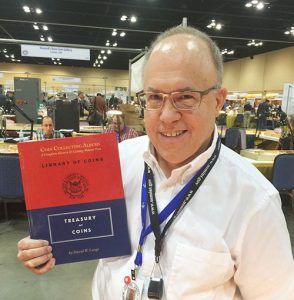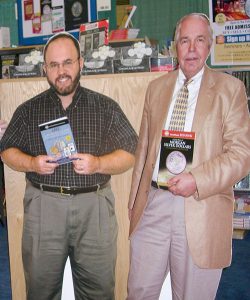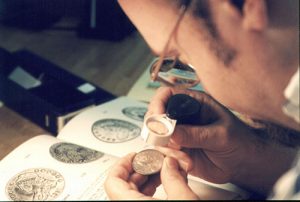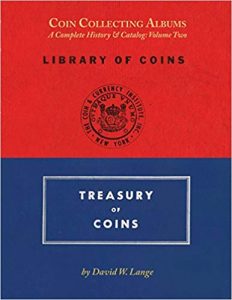
By Maggie Judkins
David W. Lange has served as director of research for Numismatic Guaranty Corporation since 1994 and is the author of nine books on United States coins and related subjects. He holds life memberships in the American Numismatic Association and the Numismatic Literary Guild. Aside from his professional work in numismatics, Lange collects and researches coin collecting boards, folders, and albums, and he maintains a website on this subject: CoinCollectingBoards.com.
Lange is the recipient of the ANA’s Lifetime Achievement Award, as well as its Numismatist of the Year honor. He is also one of the hobby’s best-known researchers and authors, having written nine books and hundreds of articles on United States numismatics. An ANA member since 1978, Lange has taught numerous courses at the ANA’s annual Summer Seminar at its headquarters in Colorado Springs, Colorado.
Besides his involvement in the ANA, Lange has been an active participant in a number of other hobby organizations. He is a former president of the Pacific Coast Numismatic Society, the California State Numismatic Association, and the New Jersey Numismatic Society, with memberships in a host of other hobby groups.
COINage: What motivated you to get started in coins, and at what age did you start?

David W. Lang: I started collecting coins at age 7 in 1965. My older brother assembled partial sets of Lincoln cents and Buffalo nickels in Whitman folders that our mother had bought him a year or so earlier. He soon lost interest and gave me the cent folders, but I had to plead to get the nickels and paid him their face value of 35 cents, which was quite a sum for a 7-year-old. The coins came with a copy of the 1964 Whitman Blue Book, my one-volume numismatic library for the next couple of years.
CA: Why did you join the ANA in 1978?
DL: I’d been collecting coins steadily since discovering the hobby, but it was not until my college years that I became seriously interested in learning more than just dates and mintages. I sought out whatever books I could find, and the persons who sold them to me frequently said that it was time to become an ANA member.
CA: How did it come about that you became NGC’s director of research?
DL: After nearly 15 years of my previous career in the engineering field, I’d decided that I didn’t want to work there another 30 years for my gold watch, or whatever one got in those days. With a couple of published coin books under my belt, I sought employment with a major numismatic firm. Jim Halperin liked my resume, but Heritage had just hired a cataloger and wasn’t in need of another. Jim informed me that Mark Salzberg was looking for a skilled numismatist and writer for a project that was then still a secret.
Before I could act on that information, I attended a reception NGC was hosting in its hotel suite during the 1994 ANA convention in Detroit, and there I met John Albanese for the first time. We talked about a number of numismatic topics, and when it came out that I’d written a couple of books and many articles, an associate of his jumped into the conversation to confirm that NGC was in need of a numismatic writer. He urged me to meet with Mark Salzberg during the following month’s Long Beach Expo, and I did just that.
I lived in California and was already sharing a table at that show, so Mark and I chatted for just a few minutes before he instructed me to set up a meeting with his head of Customer Service for an interview at NGC’s Parsippany, New Jersey, offices. When he filled me in on what NGC was planning to launch (its Photo Proof line of customized coin portfolios), I was immediately sold on the idea. I would write the text, which would then be combined with large, digital photographs (then still a rare novelty) to create what was essentially an auction catalog-style presentation of a submitter’s particular coin.
I went back to California just long enough to resign my position, say my goodbyes, and pack as much as I could before leaving, since Mark Salzberg wanted to launch at the upcoming FUN Show.
CA: What do you do as research director?

DL: I have several roles, one of which is to authenticate United States coins that are subject to counterfeiting or alteration. So a lot of 1799 cents and other rare dates come my way. I also attribute U.S. coin varieties. Until the late 1990s, NGC recognized only the major varieties illustrated in the Red Book, but we now attribute many thousands of varieties from half cents through commemoratives and world coins.
I’m the attributor for all U.S. coins except the VAM varieties of silver dollars (we get so many of those that I couldn’t do everything, and another employee now attributes the VAMs on a daily basis). I also maintain the VarietyPlus website, selecting the coins for our imaging department to photograph and writing the text. In addition, I play a similar role for NGC’s Coin Explorer online encyclopedia. It’s an immense undertaking, and the most recently completed section is Seated Liberty Half Dollars.
I also create most of the coin numbers/descriptions for the NGC database of U.S. coins. Finally, I help staff the NGC booth at major coin shows, both taking submissions from customers and answering numismatic questions. Occasionally, I’m called away to the grading room to perform variety attributions, but most of my time during shows is spent at the booth.
CA: What impact have varieties played in collecting coins?
DL: As the cost of completing a set of vintage coins has risen so much during the past few decades, more and more collectors are drawn to specialized areas such as variety collecting. The growth of variety collecting has been accompanied by solid research and literature on the subject, this replacing the guesswork and mis-attributions so common during the 1960s and earlier. Current publications and websites also offer much better photos. So it’s now more possible than ever to reliably attribute variety coins. The popularity of online collecting registries such as that maintained by NGC is also a big component in the expansion of variety collecting.
CA: What are your favorite coins to research?
DL: I wouldn’t say that I’m actually researching coins to any great extent so much as performing pedigree searches and writing text for NGC exhibits and articles. From time to time, I have to pull from my library numerous books and auction catalogs to write for a brochure to accompany these NGC exhibits.
An example is the wonderful collection of Continental dollars that was displayed at our booth during the 2017 ANA convention in Denver. My knowledge of these coins was only sketchy at first, since I work mostly with federal issues, but I came to have a much broader and deeper appreciation of them in the course of my writing. This year’s Philadelphia convention included a display of the Don Lutes, Jr. specimen of the 1943 bronze cent, and I enjoyed digging into its history. I drew upon my 1996 book “The Complete Guide to Lincoln Cents” for facts that I’d since forgotten, and it’s always good to have a refresher course.
Another recent highlight was the fourth known example of the 1854-S half eagle. Perhaps the greatest challenge was proving that this was indeed a newly discovered specimen and not the stolen Du Pont example. A 1962 promotional brochure for Stack’s Samuel Wolfson sale that I’d bought for 25 cents was among the several tools NGC used to establish that the two were indeed different examples.
CA: The hobby and science of numismatics has a graying population, and very few young people are entering the field. What needs to be done to expand and grow the hobby?
DL: Coins are now barely a part of everyday life. So it’s going to be difficult to

in this photo from 1997.
convince persons born in this century that they have any importance. It seems that most newcomers to the hobby these days are drawn first to bullion coins, and the trick is to expose them to earlier and more historically significant coins. NGC tries to do this through its Coin Explorer website, and YouTube also provides much exposure, though it’s not always accurate information. As in my own hobby experience, the best introduction to the coin hobby is still direct intervention from family or friends. We should all be missionaries seeking to spread the satisfaction to be achieved through the study and collecting of coins.
CA: Does the United States Mint help or hurt the rare coin marketplace?
DL: As I see it, the U.S. Mint’s products are a point of entry for coin enthusiasts. They’re widely advertised in both print and online media, and these modern coins will draw in persons who were not otherwise introduced to the hobby.
From 1971 onward, I was a buyer of the Mint’s annual Proof Sets and Uncirculated Sets until the ever-growing catalog of coin finishes and packaging options exhausted me some years ago. These products do draw a lot of money away from the buying of vintage coins, and I hope that many of the Mint’s customers will extend their collections beyond the new and shiny. The more adventurous persons will overcome their need for perfection in coins and will begin seeking historic issues, too.
CA: How are modern coins collected, and how have you contributed to modern coin research?
DL: It’s likely that most of the persons buying modern coins leave them in their mint-issued packaging, as only a small percentage of the total production has been certified by grading services. For those who do seek certified examples, the biggest satisfaction is found in participating in online collecting registries. I don’t know how many thousands of participants NGC’s Registry has, but I do know that there are some really amazing collections. One of my jobs is to write short essays for each of the winning entries in NGC’s annual Registry awards, and it’s always an education for me to see what others are doing.
My own contribution to the collecting of modern coins is not extensive, though I do occasionally touch on the subject for my monthly column in The Numismatist. I co-authored with Rick Montgomery the “NGC Grading Guide for Modern U.S. Coins,” and on my own I write “A Guide Book of Modern United States Proof Coin Sets” for Whitman Publishing. Researching that book revealed to me how much I did not already know when the project began. It’s now in its second edition.

CA: Some people are critical of modern coins being certified by grading services, as many modern coins automatically qualify for high grades. How would you address this criticism?
DL: What they’re saying is hard to deny for collector products minted since 1990. The U.S. Mint has maintained a very high level of quality control for its collector editions, though it still can be very challenging to find circulating pieces in the highest grades. The coins struck for general circulation as recently as the early 1980s were very poorly made and can be difficult to locate in grades that would satisfy most collectors of modern issues.
CA: What is the role of the ANA, and what can it do to help expand the hobby?
DL: Historically, the ANA’s primary role has been in fraternity between collectors and in education. As with so many areas of learning, the future lies online. The ANA has made inroads in the posting of videos on YouTube that provide that rarest of delicacies – factual information. Though I’m rather Old School myself, even I can see that it needs to become more aggressive in the areas of social media if it’s to reach young people.
Unlike many persons, I don’t obsess over the future of the hobby lying primarily with kids and young adults, as many persons only have the time and disposable income after they’ve raised a family and are gradually moving toward retirement.













